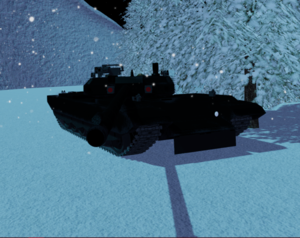R-22
| R-22 Series | |
|---|---|
 | |
| Type | Main Battle Tank |
| Place of origin | VR Socialist Soviet Republic |
| Service history | |
| In service | 2019-Present |
| Used by | VSSR |
| Production history | |
| Designer | UralVagonZavod |
| Designed | 2018 |
| Manufacturer | UralVagonZavod |
| Unit cost | R-22: $5.2 Million (2020) R-22M1: $8.3 Million (2020) |
| Produced | 2019-Present |
| No. built | 150 built (1,500 ordered, expected to be complete by 2035) |
| Variants | See Variants |
| Specifications | |
| Weight | 51 tons |
| Length | 11.98 m (gun forward) 7.62 m (hull only) |
| Width | 2.74 m |
| Height | 2.14 m (turret roof) 2.64 m (to top of CITV) |
| Crew | 3 |
| Armor | Metal-foam/graphene composite Glacis: 1,250 mm vs APFSDS 2,000 mm vs HEAT Turret Front: 1,400 mm vs APFSDS 2,600 mm vs HEAT Sideskirts: 400 mm vs APFSDS 650mm vs HEAT head-on |
Main armament | 135mm smoothbore gun |
Secondary armament | 7.62mm PK machine gun 12.7mm RWS (R-22) 20mm RWS (R-22M1) |
| Engine | 1,500 hp |
| Power/weight | 29 hp/t |
| Transmission | Continuously variable |
| Suspension | Torsion bar |
| Ground clearance | .46m |
Operational range | 450km |
| Speed | 82 km/h on-road, 58 km/h off-road |
| References | |
The R-22 is a VR Socialist Soviet Republic main battle tank. These tanks are considered to be decades ahead of their time but also fetch a high price tag, hindering the government's overly-optimistic order for 1,500 units by 2035.
Design
The R-22 makes extensive use of bleeding-edge technology such as an unmanned turret, graphene armor, and state of the art active protection system.
Armament
The main armament of the R-22 consists of a 135mm smoothbore gun. Featuring a state-of-the-art FCS, it can target and engage threats several kilometers away. It can fire RS-135M55 APFSDS rounds with certified 1,300 mm of penetration at 2km on a 90 degree slope or RSC-135M12 HEAT rounds with programmable airburst capability.
The original R-22 variant has two 7.62mm machine guns in the turret and a 12.7mm RWS on the roof. The R-22M1 replaces the 12.7 with a 20mm autocannon which can fire APFSDS and HE rounds.
Mobility
The R-22 has a 1,500hp engine, allowing it to reach speeds in excess of 80 km/h on roads. The continuously variable transmission makes the vehicle notably easy to drive even by inexperienced drivers. A suite of sensors integrated into the tank make the driver's job even easier by automatically correcting for user error and giving feedback on important systems. The vehicle has a torsion bar suspension which, while simple and reliable, is relatively old in comparison to the rest of its technology.
Protection
The R-22 makes use of graphene and titanium foam in the armor composition, allowing for incredible survivability against all modern battlefield threats. From the R-22M onwards, the vehicle is equipped with a hard/soft-kill active protection system which can intercept multiple incoming projectiles at a minimum range of 150m with a maximum velocity of 2,500 m/s. The ammo compartment is equipped with blast doors and blowout panels to reduce the risk of a catastrophic cookoff if hit. The vehicle can also be equipped with an electronic warfare defense kit which can jam nearby radio and cellular communications. This can also be used to prevent IEDs triggered in such manner to fail.
Sensors and Communication
The R-22 has a battle management system for the commander which enables him to communicate with the rest of the vehicles in the armored division. It also is equipped with GLONASS/GPS.
The commander has his own panoramic thermal sight of the third-generation. He also has his own laser rangefinder and can take control of the turret and gun to engage a target quickly. He controls the RWS via his control panel.
The gunner has a third-generation thermal sight with both a conventional laser rangefinder and a digital-optical rangefinder which uses a binocular camera and AI technology to estimate the range to a target without emitting any form of detectable laser or radar energy.
Variants
R-22
Initial production variant. It lacks the APS and 20mm RWS found on later variants.
R-22M
An extensive upgrade of electronics and other minor changes.
- The "Steel Wall" hard/soft-kill active protection system is added.
- Graphene layers in the sideskirts are redesigned to increase protection against shaped charge weapons such as ATGMs and RPGs.
R-22M1
A minor upgrade to the R-22M which adds a bustle rack with integrated slat armor .
R-22M2
A moderate upgrade adding a new type of interim modular APS in the meantime while a purpose built one for the tank is designed. It saw no significant armor or firepower upgrades.
R-22M3
A massive overhaul of the vehicle, seeing a whole new compeoite armor package fitted, increasing its survivability in urban warfare. Once this variant was designed, the original R-22 and the R-22M variants were deemed old enough to be exported to allies. Some earlier variants lack the addon armor on the upper front plate, often informally called R-22M3 Early.
R-22M4
Yet another massive overhaul with another brand new and even more advanced composite armor package fitted, this one being more efficient with weight and also keeping the visible silhouette of the vehicle smaller. Some were fitted with an experimental directed energy APS powered by a high capacity graphene battery bank. an example of this bariant and its presumed armor thickness can be found here.
Operators
VR Socialist Soviet Republic
- R-22 - 25 (Initial production version)
- R-22M - 50 (Upgraded version, 500 ordered)
- R-22M1 - 75 (Newest version, 1,000 ordered)